In 2018, the National Academies of Sciences, Engineering, and Medicine published Transforming the Financing of Early Care and Education, focused on how to fund early care and education for children from birth to kindergarten in a manner consistent with the recommendations outlined in the 2016 Transforming the Workforce report. Current funding levels for early education programs are mostly inadequate and ineffective, leading to high tuition for parents, low wages for educators, limited resources for professional learning, and other problems that make it difficult to provide quality services. The multiple and fragmented funding streams make the existing system difficult for families to navigate and burdensome for providers. The report estimates that it would cost $139.9 billion each year to provide high-quality early childhood education that meets the needs of American children, families, and the workforce. The writers suggest this funding come from public investment at various levels of government, as well as family contributions and private funding. For the public portion, they recommend spending $53 billion above the $29 billion that is currently paid by public funds. This report, based on the consensus of 17 experts in finance and education, argues that increased public investment is necessary to ensure adequate access to high-quality programs and that low-income families should not be expected to pay out of pocket.
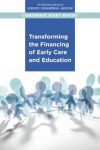
LaRue Allen and Emily P. Backes, eds. Transforming the Financing of Early Care and Education (Washington, DC: National Academies Press, 2018). Available at https://doi.org/10.17226/24984.
A 2016 paper by W. Steven Barnett and Richard Kasmin, Funding Landscape for Preschool with a Highly Qualified Workforce, states that state pre-K funding levels are rarely based on the actual cost of providing a high-quality program. State-level funding per child is instead often determined by the state’s appropriation for pre-K and annual enrollment, instead of starting with the amount needed to best serve the child. The report argues that more states should fund pre-K through school funding formulas that fund K–12 education, because they enable more adequate and stable funding. More funding could be used to increase early educator pay and benefits. In 2018, Barnett and Kasmin wrote an article published by the National Association of State Boards of Education encouraging those boards to fully fund state pre-K programs through school funding formulas.
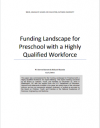
W. Steven Barnett and Richard Kasmin, Funding Landscape for Preschool with a Highly Qualified Workforce (New Brunswick, NJ: National Institute for Early Education Research at Rutgers University, 2016). Available at https://sites.nationalacademies.org/cs/groups/dbassesite/documents/webpage/dbasse_176099.pdf.

W. Steven Barnett and Richard Kasmin, Fully Funding Pre-K through K–12 Funding Formulas (Arlington, VA: National Association of State Boards of Education, 2018). Available at http://www.nasbe.org/wp-content/uploads/2018/01/Barnett-Kasmin_Jan-2018-Standard.pdf.
In 2018, the Education Commission of the States released How States Fund Pre-K: A Primer for Policymakers, which provides a helpful overview of the different revenue streams that states use to fund pre-K and the potential benefits and drawbacks of each method.
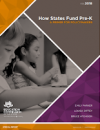
Emily Parker, Louisa Diffey, and Bruce Atchison, How States Fund Pre-K: A Primer for Policymakers (Denver: Education Commission of the States, 2018). Available at https://www.ecs.org/wp-content/uploads/How_States_Fund_Pre-K.pdf.
The Center for Enhancing Early Learning Outcomes has released a toolkit to help policymakers use its Cost of Preschool Quality & Revenue (CPQ&R) calculator, which is free. The calculator incorporates research to help users determine the cost of implementing a high-quality pre-K program, taking into account the National Institute for Early Education Research (NIEER) 2016 preschool quality standards.
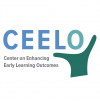
See the “Cost of Preschool Quality & Revenue Calculator” created by the Center on Enhancing Early Learning Outcomes: http://ceelo.org/cost-of-preschool-quality-tool/.
In 2017, the National Institute for Early Education Research (NIEER) and the Center for the Study of Child Care Employment (CSCCE) partnered to analyze compensation parity among public pre-K programs to see if pre-K educators receive equivalent compensation to their K–3 counterparts. They published one brief that offers a framework for understanding compensation parity and a second brief that digs into state policies around pre-K teacher pay. Based on their definition, only four states provide full compensation parity for pre-K teachers and those in other grades. Those states are New Jersey, New Mexico, North Carolina, and Tennessee.
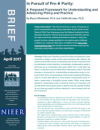
Marcy Whitebook and Caitlin McLean, In Pursuit of Pre-K Parity: A Proposed Framework for Understanding and Advancing Policy and Practice (Berkeley, CA: Center for the Study of Child Care Employment and National Institute for Early Education Research, 2017). Available at http://nieer.org/wp-content/uploads/2017/04/Pre-K-Parity-Brief_Final-1.pdf.
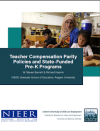
W. Steven Barnett and Richard Kasmin, Teacher Compensation Parity Policies and State-Funded Pre-K Programs (New Brunswick, NJ: National Institute of Early Education Research at Rutgers University, 2017). Available at
http://nieer.org/wp-content/uploads/2017/10/Teacher-Compensation-Parity-Policies.pdf.
In 2014, the Center for the Study of Child Care Employment at the University of California–Berkeley released Worthy Work, STILL Unlivable Wages, a report on the state of the child care workforce. The writers found that despite our greater understanding about the importance of high-quality early learning experiences over 25 years, not to mention insights from brain science, earnings for early childhood educators have not improved. Many early educators live in poverty and turnover in the field is high. Even pre-K teachers with bachelor’s degrees earn less than elementary school teachers, on average.
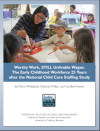
Marcy Whitebook, Deborah Phillips, and Carollee Howes, Worthy Work, STILL Unlivable Wages: The Early Childhood Workforce 25 Years after the National Child Care Staffing Study (Berkeley, CA: Center for the Study of Child Care Employment, 2014). Available at
http://cscce.berkeley.edu/files/2014/ReportFINAL.pdf.
Numerous cost-benefit analyses of early learning programs, including publicly funded pre-K, have emerged in recent years and have shown a high return on investment. In October 2013, leading experts in early childhood education wrote Investing in Our Future: The Evidence Base on Preschool Education, compiling the evidence on the benefits of high-quality pre-K. They concluded that “high-quality early childhood education programs are among the most cost-effective educational interventions and are likely to be profitable investments for society as a whole.” Schools spend less on special education and grade retention; communities benefit from members of society having less need for welfare services and fewer engagements with the criminal justice system; and individuals benefit from higher earnings as adults.

Hirokazu Yoshikawa, Christina Weiland, Jeanne Brooks-Gunn, Margaret R. Burchinal, Linda M. Espinosa, William T. Gormley, Jens Ludwig, Katherine A. Magnuson, Deborah Phillips, and Martha J. Zaslow, Investing in Our Future: The Evidence Base on Preschool Education (New York: Foundation for Child Development, 2013). Available at https://www.fcd-us.org/the-evidence-base-on-preschool/.